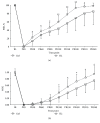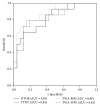Inhaling Hydrogen Ameliorates Early Postresuscitation EEG Characteristics in an Asphyxial Cardiac Arrest Rat Model
- PMID: 31737671
- PMCID: PMC6815975
- DOI: 10.1155/2019/6410159
Inhaling Hydrogen Ameliorates Early Postresuscitation EEG Characteristics in an Asphyxial Cardiac Arrest Rat Model
Abstract
Background: Electroencephalography (EEG) is commonly used to assess the neurological prognosis of comatose patients after cardiac arrest (CA). However, the early prognostic accuracy of EEG may be affected by postresuscitation interventions. Recent animal studies found that hydrogen inhalation after CA greatly improved neurological outcomes by selectively neutralizing highly reactive oxidants, but the effect of hydrogen inhalation on EEG recovery and its prognostication value are still unclear. The present study investigated the effects of hydrogen inhalation on early postresuscitation EEG characteristics in an asphyxial CA rat model.
Methods: Cardiopulmonary resuscitation was initiated after 5 min of untreated CA in 40 adult female Sprague-Dawley rats. Animals were randomized for ventilation with 98% oxygen plus 2% hydrogen (H2) or 98% oxygen plus 2% nitrogen (Ctrl) under normothermia for 1 h. EEG characteristics were continuously recorded for 4 h, and the relationships between quantitative EEG characteristics and 96 h neurological outcomes were investigated.
Results: No differences in baseline and resuscitation data were observed between groups, but the survival rate was significantly higher in the H2 group than in the Ctrl group (90% vs. 40%, P < 0.01). Compared to the Ctrl group, the H2 group showed a shorter burst onset time (21.85 [20.00-23.38] vs. 25.70 [22.48-30.05], P < 0.01) and time to normal trace (169.83 [161.63-208.55] vs. 208.39 [186.29-248.80], P < 0.01). Additionally, the burst suppression ratio (0.66 ± 0.09 vs. 0.52 ± 0.17, P < 0.01) and weighted-permutation entropy (0.47 ± 0.16 vs. 0.34 ± 0.13, P < 0.01) were markedly higher in the H2 group. The areas under the receiver operating characteristic curves for the 4 EEG characteristics in predicting survival were 0.82, 0.84, 0.88, and 0.83, respectively.
Conclusions: In this asphyxial CA rat model, the improved postresuscitation EEG characteristics for animals treated with hydrogen are correlated with the better 96 h neurological outcome and predicted survival.
Copyright © 2019 Gang Chen et al.
Conflict of interest statement
The authors declare that they have no conflicts of interest.
Figures





Similar articles
-
Interaction between gender and post resuscitation interventions on neurological outcome in an asphyxial rat model of cardiac arrest.BMC Cardiovasc Disord. 2021 Sep 16;21(1):441. doi: 10.1186/s12872-021-02262-5. BMC Cardiovasc Disord. 2021. PMID: 34530726 Free PMC article.
-
Combining early post-resuscitation EEG and HRV features improves the prognostic performance in cardiac arrest model of rats.Am J Emerg Med. 2018 Dec;36(12):2242-2248. doi: 10.1016/j.ajem.2018.04.017. Epub 2018 Apr 9. Am J Emerg Med. 2018. PMID: 29661665
-
Comparison of Quantitative Characteristics of Early Post-resuscitation EEG Between Asphyxial and Ventricular Fibrillation Cardiac Arrest in Rats.Neurocrit Care. 2018 Apr;28(2):247-256. doi: 10.1007/s12028-017-0401-z. Neurocrit Care. 2018. PMID: 28484928
-
The pathophysiologies of asphyxial vs dysrhythmic cardiac arrest: implications for resuscitation and post-event management.Am J Emerg Med. 2015 Sep;33(9):1297-304. doi: 10.1016/j.ajem.2015.06.066. Epub 2015 Jul 6. Am J Emerg Med. 2015. PMID: 26233618 Review.
-
Clinical neurophysiologic monitoring and brain injury from cardiac arrest.Neurol Clin. 2006 Feb;24(1):89-106. doi: 10.1016/j.ncl.2005.11.003. Neurol Clin. 2006. PMID: 16443132 Review.
Cited by
-
Rat model of asphyxia-induced cardiac arrest and resuscitation.Front Neurosci. 2023 Jan 4;16:1087725. doi: 10.3389/fnins.2022.1087725. eCollection 2022. Front Neurosci. 2023. PMID: 36685224 Free PMC article. Review.
-
Influence of oxygen concentration on the neuroprotective effect of hydrogen inhalation in a rat model of cardiac arrest.Front Neurol. 2022 Sep 29;13:996112. doi: 10.3389/fneur.2022.996112. eCollection 2022. Front Neurol. 2022. PMID: 36247780 Free PMC article.
-
Neuroprotective Approaches for Brain Injury After Cardiac Arrest: Current Trends and Prospective Avenues.J Stroke. 2024 May;26(2):203-230. doi: 10.5853/jos.2023.04329. Epub 2024 May 30. J Stroke. 2024. PMID: 38836269 Free PMC article. Review.
References
MeSH terms
Substances
LinkOut - more resources
Full Text Sources
Medical

